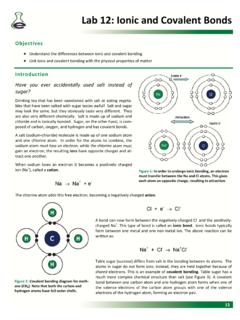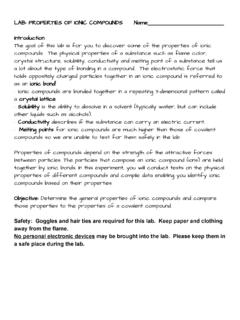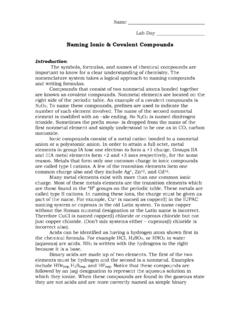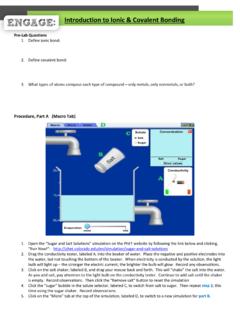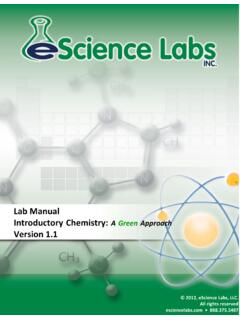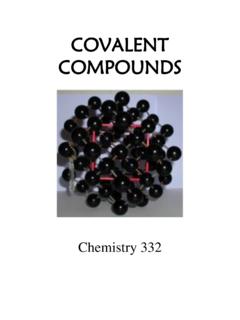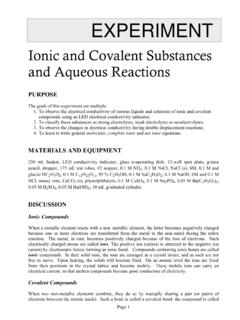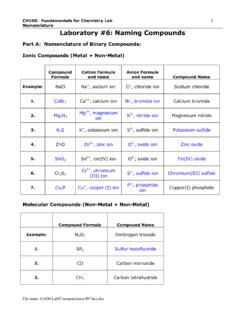Transcription of Ionic vs. Covalent Compounds Lab - jfindlay.ca
1 Ionic VS. Covalent Compounds LAB A compound is defined as a chemical combination of two or more elements. A chemical bond is the glue holding together atoms of different elements. Ionic bonds generally occur between a metallic element and a nonmetallic element. Covalent bonds generally occur between two or more nonmetallic elements. In this experiment, you will observe several properties of some Ionic and Covalent Compounds and attempt to recognize patterns among the properties. Keep in mind that with any classification system, there will be some exceptions to the overall pattern. PURPOSE 1) To observe and record properties of Ionic and Covalent Compounds . 2) To use properties of substances as a means of identifying whether it is Ionic or Covalent PRELAB DEMONSTRATION compound Appearance & State Melting Point (High or Low) Odour (Yes/No) Solubility in water (Yes/No) Conductivity Very high High Low None Ionic or Covalent ?
2 H2O (tap water) H2O (distilled water) C2H6O Ethanol CO2 MATERIALS Compounds A, B, C, & D conductivity testers distilled water 2 test tubes test tube rack scoopula stirring rod stopper SAFETY The Compounds used in this experiment may cause skin, nasal, and eye irritation. Avoid direct contact and/or inhalation. If contact with the skin does occur, notify your teacher and flush the affected area with water. NOTE: You will be sharing the unknown materials at your desk with other group members. DO NOT CROSS CONTAMINATE samples and return samples to the center of the lab bench. Ionic vs. Covalent Compounds Lab CHEM PROCEDURE 1. Observe the teacher placing a small sample of each unknown into a separate test tube and holding the test tube over the flame of a Bunsen burner. Record your observations in the observation chart.
3 2. One at a time, obtain the beakers labeled A, B, C, and D. Observe the odor and appearance of each compound and record your observations in the data table. CAUTION: Observe the odor of the sample in the beaker by wafting towards your nose. Do not directly inhale. 3. Use the scoopula to obtain PEA-SIZED samples of each compound and place them in the appropriate test tubes. Be sure to rinse and dry the scoopula after obtaining each sample to avoid contamination. 4. Fill each test tube to about 1/3-full with distilled water. Stir with the stirring rod and record your observations as to whether or not the compound dissolves. Be sure to rinse the stirring rod with distilled water after testing each compound to avoid contamination. 5. Pour the sample of the test tube mixture into an empty beaker so that there is about 1 2 cm of the liquid inside. Use the conductivity tester to test the conductivity of each sample.
4 Dip the electrodes of the conductivity tester into the liquid (DO NOT TOUCH ANY PART OF THE CIRCUIT TO THE LIQUID). Record your observations. RINSE the conductivity tester in between samples with distilled water to avoid cross-contamination. 6. Rinse all glassware and leave all materials and equipment in a neat, organized manner in which you found them. Marks will be deducted for stations that are not cleaned up properly. Ionic vs. Covalent Compounds Lab CHEM OBSERVATIONS Record all of the data from the lab in the following table. Mystery compound Appearance & State Melting Point (High or Low) (Teacher will demo) Odour (Yes/No) Solubility in water (Yes/No) Conductivity Very high High Low None Ionic or Covalent ? A B C D Ionic vs. Covalent Compounds Lab CHEM ANALYSIS/CONCLUSIONS 1. The chemical formulas for the four unknown substances used in the lab are listed below.
5 Match each substance to the correct unknown letter A, B, C, or D. Put the name in the last column of your observation table where you decided whether it was Ionic or Covalent . Which substance(s) were difficult to match to and why? What information or further testing could you have used to help you decide on the identity of each unknown? 2. Complete the table below. Type of compound State (solid, liquid, gas) Melting Point/ Boiling Point (High/Low) Odour (Yes/No) Conductivity (yes/no) Hardness (hard/soft) Solubility in Water (yes/no/sometimes) Ionic Compounds Covalent Compounds 3. Read p. 210 211 of the textbook. Use this to answer the following questions on a separate sheet of paper. a) Research one molecular compound that is of significance in your life. What are its properties? How do these properties determine the use and/or hazards of this compound ?
6 B) What property of oil makes oil leaks such an environmental catastrophe? c) How are some of these toxins, such as trichloroethene, currently being removed from water? Would this process be an example of a physical or chemical change? Explain. NaCl C12H22O11 (powdered sugar) C18H36O2 (stearic acid) Na2SO4 Ionic vs. Covalent Compounds Lab CHEM 4. Review the properties of the Compounds shown below. Is the compound Ionic or Covalent ? Provide rational for your choice. Ionic OR Covalent State (solid, liquid, gas) Melting Point/ Boiling Point (oC) Odour (Yes/No) Conductivity (yes/no) Solubility in Water (yes/no) Rationale Solid 620 None Yes in (aq) solution Yes Liquid 7 Yes None No Solid 100 None None Yes Solid 270 None Yes in (aq) solution Yes 5. Using the patterns established in this experiment and the information in your notes, predict the properties of the following substances.
7 Provide your rationale. Compare your predictions to the actual properties by conducting some research. Type of compound State (solid, liquid, gas) Melting Point/ Boiling Point (oC) Odour (Yes/No) Conductivity (yes/no) Hardness (hard/soft) Solubility in Water (yes/no) Carbon disulfide Gasoline (C8H18) Cobalt (II) chloride Ionic vs. Covalent Compounds Lab CHEM 6. a) Why is it that Ionic Compounds do not conduct electricity in their crystalline form. (ie: what is needed for electricity to flow?) b) Why aren t Covalent Compounds conductive? (ie: what is needed for electricity to flow?) 7. Why do Covalent Compounds have significantly lower melting/boiling points than Ionic Compounds ? Ionic vs. Covalent Compounds Lab CHEM ANSWER KEY A C18H36O2, B NaCl, C Na2SO4, D C12H22O11
